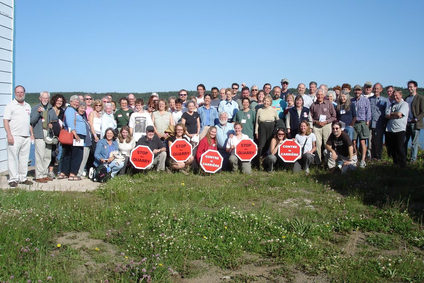
Thirteen years ago, I was hired as a consultant to provide expert advice on the impacts of the Digby Quarry. The local community had become alarmed about the quarry when they heard about plans to build a marine terminal at the site. Clearly, the quarry, which was originally 3.9 hectares –the size of quarry that eludes environmental assessment in Nova Scotia –was going to be much larger than they had thought. Turned out, a 120 hectare quarry was planned, located 50 metres from the shoreline. Basalt rock from the quarry was to be exported in large bulk carriers that would transit the Bay of Fundy.
As with most work on environmental issues, my job was not just to cover the impacts of the quarry – with particular emphasis on invasive species in this case – but also its impacts on the people in the area and the communities they create together. Participants in Environmental Assessments are supported for the very reason that they can bring this type of detailed and place-based information to the assessment process.
One of my first forays as a participant involved a beautiful lunch hosted by Carol and Ashraf Mahtab at their home in Sandy Cove. The home they had created encapsulated the peace and purpose that made the area so special. Carol’s artwork hung on the walls, abstract images that somehow conveyed sea, sand, and air.
The conversation was full of laughter, information, and strategies to “Stop the Quarry.” I still have the right whale magnet given to me that day, created by a local artist to support the cause. Sierra Club Atlantic Chapter’s Conservation Chair, Mark Dittrick, was also there, sharing detailed knowledge about the project, which was literally happening on his doorstep, and his expertise on how blasting at the quarry and ship traffic would harm the critically endangered North Atlantic right whale.
After an intensive environmental assessment process, Canada’s and Nova Scotia’s Ministers of Environment rejected the quarry in 2007. Community members, who had spent the last five years bringing expertise to the assessment – not to mention organizing public events, lobster suppers, community fundraisers, and even hosting a joint Sierra Club US and Canada meeting on the Neck – breathed a sigh of relief.
Now, all these years later we are in court with our colleagues from East Coast Environmental Law, with the help of lawyers from Ecojustice, trying to defend the decision to reject the quarry. Bilcon, a US-based quarry company, turned to a NAFTA Tribunal, to seek compensation for the decision to reject the quarry, on the basis that it was an unfair trade practice – and is asking for compensation of 101 million USD ($130 million CDN).
It’s frustrating, to say the least, that the expertise and voices of the community were questioned by a NAFTA Tribunal. But not surprising. Our trade expert, Janet Eaton, warned the Panel assessing the quarry that investor-state provisions in NAFTA could threaten Canadians’ ability to make a decision about this project. Unfortunately, she has proved to be all too correct.
It’s alarming that the majority members of the three-person Tribunal found in favour of Bilcon last year. To quote environmental assessment guru, Meinhard Doelle, the fact that a trade tribunal could be used to overturn the result of an environmental assessment is “frightening.”
We really had no choice but to join in this case, given our long history fighting to stop the quarry and our role as an organization in defending the environmental assessment law it threatens.We can’t let this case prove that free trade deals rob citizens of their freedom to choose when it comes to projects that would damage the environment and the society on which it relies.
